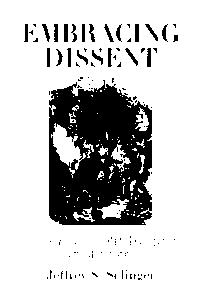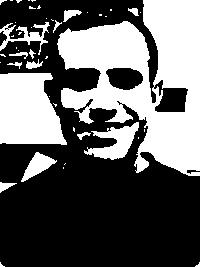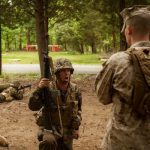 When democratic presidential hopeful Hilary Clinton describes her GOP opponent Donald Trump as “dangerous,” or vice versa, what does that really mean? How “dangerous” can a politician be in the twenty-first century? It’s a question of particular interest to Assistant Professor of Government Jeffrey Selinger, who in his latest book examines how US party politics evolved in the early years of the Republic.
When democratic presidential hopeful Hilary Clinton describes her GOP opponent Donald Trump as “dangerous,” or vice versa, what does that really mean? How “dangerous” can a politician be in the twenty-first century? It’s a question of particular interest to Assistant Professor of Government Jeffrey Selinger, who in his latest book examines how US party politics evolved in the early years of the Republic.
Embracing Dissent: Political Violence and Party Development in the United States (Philadelphia: University of Pennsylvania Press, 2016) looks at how political competition, rather than political violence, became the norm. This book, Selinger argues, also provides some useful historical perspective on today’s polarized political landscape.
Selinger was interviewed by College Writer and Multimedia Producer Tom Porter on WBOR Radio.
Listen to the interview (audio make take a few seconds to load):
Edited interview transcript:
Tom Porter: The starting point of your book seems to be that when the USA was founded, it was far from certain that political opponents would be able to conduct themselves peacefully when it came to the transfer of power. Is that a fair assessment?
Jeffrey Selinger: Yes that is the analytical hook. The point of departure I suppose would be that the founders fully expected political parties, or something like them, would develop, and should they take center stage and constitute the organizing impulses that drive American politics, then the Republic would not last very long. And so the question is, how is it that we have gone from that situation, where parties were viewed as an inevitability but a danger, to an alternative view where we can’t conceive of democracy absent party opposition? Where democracy is essential to make the regime itself legitimate. And so the book is a study of the development of the idea of legitimate party opposition and how that process of legitimation unfolded over time.
TP: Do you think there was a perceived physical threat to the Republic in those early days because maybe not everyone was as invested in the idea of the Republic as the founding fathers?
JS: Well they certainly had deeply contrasting senses of how the Republic should be organized, or if it should be organized as one Republic or many. This was one of the central organizing questions that was raised in the 1780s. When scholars have looked at the development of party opposition and the legitimation of party opposition, they have tended to focus on the role that ideas played, whether they were ideas drawn from classical liberalism or the small ‘r’ republican tradition. The argument that I make is that actually there was a kind of real politics, or structural institutional politics, that drove ideas about legitimate party opposition. In other words, the legitimacy of opposition hinged in no small part on the very real and perceived vulnerabilities of the regime. For example, before the Civil War, the great threat to the Republic was the threat of secession that would be triggered by the question of slavery. So the idea of legitimate party opposition was bounded by this substantive question that parties could be legitimate so long as they did not politicize the question of slavery. So certain structural vulnerabilities define and shape the ideas that we have about party legitimacy.
TP: Going back to the revolutionary years , when was the first transfer of power after revolution and how peaceful was it?
JS: It was 1800, and it was very, I would say, fortuitous from the vantage point of those who wanted to preserve the Republic, that were was a peaceful transfer of power. It was a contested election which Thomas Jefferson won, but the original constitution did not afford an opportunity for electors to distinguish between the president and vice-president. So Aaron Burr, who was supposed to be the vice-president, received an equal number of electoral votes as Jefferson, which meant there was no clear winner even though everyone really understood that Jefferson was intended to be the president. This meant that the opposition party, the Federalists, had the option to cut a deal with Burr and put him in as president instead. Ultimately however they exercised a degree of restraint, and the reason they exercise this restraint – and this is something I discuss in the book – is because they had every reason to fear that there would be, if not a civil war, at least the potential of a separatist movement if they did not.
TP: At what point would you say that politics became a “safe” and “normal” feature of American political life?
JS: There are two really crucial stages that I discuss at length in the book. Firstly, there’s a great deal to be said about the constitution itself and how the constitution in the electoral process and the governing process that it defines, delimited and bounded the sphere of what would actually be contested. For example you can think about how the first amendment effectively sets the limit for religion by identifying a right to freedom or worship but also stipulating that Congress shall make no law, effectively saying that religion is not something that Congress is going to be legislating and therefore removing it from the political agenda. So through the Bill of Rights and a number of other means, the constitution narrowed the scope of conflict and the produced a more temperate set of parties. They were moderate and incremental in their orientation.
The other major decisive turning point would be the conclusion of the Civil War and the settlement that came with Reconstruction. While the Civil War and Reconstruction did not do justice by African-American freedman and women, it did establish that there is no exit from the union: secession and separatism were effectively futile and there was no real or meaningful fear that parties or partisanship would devolve into civil war or into a separatist crisis.
TP: Looking at more contemporary politics, some commentators say the current electoral cycle is shaping up to be the most violent one since 1968, when the Democratic National Convention in Chicago was scene of violent confrontations. Do you agree?
JS: There has been an outcropping of what might be called petty violence, sucker punches and little shoving matches in the street. But this is not the kind of violence my book focuses on, which is the violence that actually threatens the structure of government: violence that could undermine or introduce a degree of instability in the institutions of government, that could have a long-term and subversive impact on the regime that we have taken for granted.
If there is a threat presented by a person like Donald Trump for example, who is very much in the news at the moment, it is that this figure seems to be completely unencumbered by alliances or the need to build relationships. There is a fear in some quarters that Trump poses a threat to the steady management, and oversight of, government, should he become the nation’s next chief executive. Today, for example, we have a global, interconnected market economy, where there are commercial transactions and financial flows that can be interfered with, and interrupted by, a president who does not use his office in a way that sends cues that there will be interruptions. And even just the fear of this happening can itself interrupt the way in which investors and political actors abroad and at home involve themselves in financial and other kinds of markets.
TP: So it’s the unpredictability of a character like Donald Trump which could be perceived as “dangerous”?
JS: It is, but it’s also revealing that the question of serious, violent, domestic disturbances is still unthinkable, and that does represent itself a very significant accomplishment.
TP: So when we use the word “dangerous” today, for example when Hillary Clinton describes Donald Trump that way, it’s a long way from meaning what it meant back in the years covered by your book?
JS: Exactly

